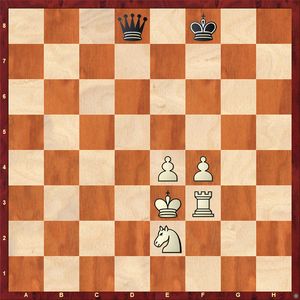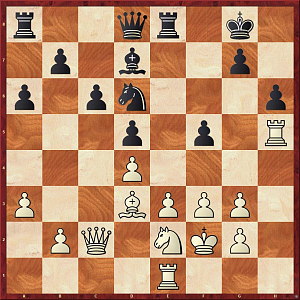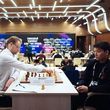How +0.7 is Better Than +0.5?
Dmitry Kryakvin makes his way through the first adrenaline rush sensations of the Carlsen vs Nepomniachtchi match.
As of last decade, the computer has turned into a universal tool for online broadcasts of the world's largest competitions. Alas, there used to be times when everyone was eager to hear grandmaster’s opinion in an attempt to comprehend the train of thought of a champion and a challenger. There was even a kind of rate that allowed not too qualified journalists write reports with statements from the members of the Soviet team included. Well, the most sweet Mikhail Tal always helped correspondents without any charges, but they told me how Viktor Korchnoi lashed out at one of the wordsmiths during the Petrosian – Spassky match. Viktor Lvovich has just been gifted lavishly by Tigran Vartanovich's compatriots when a somewhat insolent onlooker happened to voice his observation. “What category player you say you are in the first place? A candidate master? Look at you butting in so boldly and empty-handedly! A pretty weak candidate master you must be, the way I see it! No excuses for your inability to evaluate the inner workings of this adjourned game’s position!” – was Korchnoi’s indignation for quite some time yet.
However, even with the fantastic, almost out of this earth’s power of analytical engines in which Stockfish's calculation is enhanced by strategic vision and understanding of neural networks, some territory remains uncharted anyway. Here, in Dubai, when the eval bar displays +0.5 in challenger’s favor, the entire Russia is ready to shout in unison: “Time to remove your crown, Magnus!”. On the contrary, the eval bar reads -0.7, and the Western fans start to rejoice: «Magnus forever!» But in fact, here they are trading many pieces and the game ends in a draw. At the press conference the players say that these pluses and minuses meant nothing from a human player's point of view. Even though the zero evaluation has been seen many times in tournament games already, it is clear to the naked eye that this position is incredibly dangerous for a weak human chess player. The computer has become so powerful that sometimes it takes you an hour to figure out why it moved a pawn one and not up two squares in the first place.
What evaluation stands for substantial advantage then? A good friend of mine, a grandmaster, claimed that when he had +0.7 or +0.8, he mentally awarded himself a point in his best years of chess career. Yet another pal of mine, much more modest and not so arrogant, told me that +0.5 is enough for two players to feel comfortable. It is same as if you were at a banquet, when an increase to +0.7 proves too much more often than not. However, you probably know yourself that sometimes to convert even as much as +2.00 proves an extremely challenging task indeed.
Let's go over the critical moments of the first six games between Magnus Carlsen and Ian Nepomniachtchi (the score is no longer level, and it is obvious that it marks the end of a certain part of the match, and that beginning with game seven the battle will proceed to slightly different rules), while paying attention to what those very tenths or hundredths of evaluation figures stood for in reality.
Nepomniachtchi – Carlsen
This is game one.

Here Carlen player 38...Kf7?!, exposing himself to the family fork from е5 and giving Ian a chance to quickly equalize by making his knight active: 39.Ree1 Kf6 40.Ne3! Rd7 41.Nc4 (the fork threat is in the air again) 41…Re7 42.Ne5 Rd6 43.Nc4 Rc6 44.Ne5 Rd6 45.Nc4.
This is when all commentators highlighted the nice-looking continuation 38...a5, and 39.R:a5? fails to 39...Nd4+! 40.Kd1 (40.Kc1? Nb3+; 40.cd? cd+ with a fork) 40...Rb1+ 41.Kd2 Rcb6! (this is what Magnus must have overlooked) 42.cd (42.Ra2 Nb3+ 43.Kc2 Rc1+ 44.Kb2 Rf1 and Black wins)42...cd 43.Ra8+ Kf7 44.Ra7+ Kf6, and the white rook is en prise and the threat of mate is in the air.
However, how realistic Black's chances of winning were no matter the engine’s excitement? When analyzing for ChessBase.сom, the well-known GM Michael Adams showed the line 39.Ree1 Rcb6 40.Ra2 a4 41.Ne3 Ra6 42.Rea1 Rba7, and the passed pawn renders White’s position difficult to defend. However, what about 39.Re2! Rcb6 40.Kc1, intending 40...Ra6 41.Rea2 Rba7 42.Ra4 and blockading the dangerous passed pawn immediately? Of course, the a-pawn move would have been a great practical chance, but with Ian should have made a draw with calm play.
The goal-scoring momentum was seemingly near the world champion's gates in game two.
Carlsen – Nepomniachtchi

Here Ian played it too safely 26…ba, and after 27.Q:a4 Rfd8 28.Ra1 c5 29.Qc4 B:e4 30.N:e4 Kh8 31.Nd6 Rb6 32.Q:c5 Rdb8 33.Kg2 a6 34.Kh3 Rc6 35.Qd4 Kg8 36.c4 Qc7 37.Qg4 R:d6 38.ed Q:d6 and there arose the rook ending with 3 vs 2 pawns that Nepomniachtchi had no problems to defend.
The computer’s first line is 26...Qg7! 27.f4 g5. Adam Tukhaev (ChessPro): «Probably, here Nepomniachtchi missed his golden chance in game two: the computer shows a powerful idea 26...Qg7 27.f4 g5!, and White has problems (of course, it is extremely difficult to go for such a weakening of own king) ".
Luke McShane also spoke on ChessBase in a similar vein (for my part, it would be fair to share viewpoints of both Russian and Western biggest chess sites): «26...Qg7 27.f4 g5! was worth evaluating, and the engine votes for Black in this position. But who would willingly agree to weaken the kingside with passive pieces still sitting in home ranks?"
Imagine my surprise when a deep dive into the position showed that Black was nearly winning! Of course, not by force, and White still had practical chances, however ...
28.Qa2 gf 29.Q:e6+ Kh8 30.ab
White could fight for salvation via 30.Nf5 Qg6 31.Q:g6 hg 32.Nh4 Rfd8 33.N:g6+ Kg8, and with queens off the board the king is actually safe.
30...fg 31.bc gh+ 32.Kh1 Rf4!! (this only move might be hard to spot from afar) 33.Qd7 (33.Bg2 Rg8) 33...R:e4 34.Q:g7+ K:g7 35.N:e4 B:c6 36.Re1 Rb2, winning.
So much for the g7-queen! By the way, if elsewhere the evaluations really oscillate from +0.5 to +0.7, then here we immediately see the evaluation skyrocketing. As you go deeper in the position, Black's advantage becomes stronger…
On the ChessPro broadcast, GM Michal Krasenkow voiced a very interesting point about game three related to our topic.
Nepomniachtchi – Carlsen

«If, say, 21.Qd3 then there follows a pawn sacrifice: 21...d5!? 22.Bxf6 Qxf6 23.exd5 Bf5, and this is sort of deja-vu from game one. By the way, there is nothing better for White at the moment as d6-d5 is a positional threat.
I have something to add to the discussion in the chat: when the engines give + 0.30-0.40, it can be either complete equality or a huge advantage. This is more so that we are talking about human players and not engines. Therefore, you should always aim at evaluating the position yourself. Ian took a deep think here. It is not that simple to find a continuation to get at least a practical chance of success. By the way, in many forced lines the position becomes open and it is of importance that White does not have a luft” (M. Krasenkow).
As if hearing Krasenkow, Nepomniachtchi played 21.h3 c6 22.Bc2 d5! 23.e5 dc 24.Q:d8 Re:d8 25.ef Bb4 26.fg B:c3 27.bc K:g7 with a quick draw. On the contrary, David Navara, commenting for the Chessbase, believed that White no longer had a choice and should grab the pawn anyway: 21.Qd3!? d5 22.B:f6 Q:f6 23.ed Bd7 (23...Bf5 24.Qf3 is not so precise) 24.Qc3.
Let's see what is going on: 24…R:e1+ 25.R:e1 Rb8 26.Bc2 Rb4 27.Q:f6 gf 28.b3 B:a4 29.N:a5 Bb5 – this is definitely not the position that Carlsen would have lost. Well, in the worst case scenario he could transpose into an opposite-colored bishops ending with his bishops still very powerful, and White is tied to defending his extra pawn.
In game four, only a weak engine on Chessbomb awarded White with a small plus – any strong engine showed that the move of the black passed a-pawn would have forced the world champion to go for a perpetual check. In the next fight there again arose a position that fits our topic of discussion.
Nepomniachtchi – Carlsen

The Russian team finally pressed the world champion against the ropes in Ruy Lopez, but Ian played indecisively: 20.Red1 Be6 21.Ba4 Bd7 22.Nd2 B:a4 23.Q:a4 Q:a4 24.R:a4 Ra8 25.Rda1 R:a4 26.R:a4 Rb8 27.Ra6 Ne8 – Magnus defended his с7 and g7 weaknesses to make a confident draw.
White could have maintained initiative with 20.c4!, and if Black does not defend precisely he is in trouble immediately: 20...c5 21.Ba4 or 20...Be6 21.Ba4 Bd7 22.c5 (Evgeny Gleizerov), oppressing the poor d6-bishop. However, Black could have come up with the much stronger: 21…Qe6! 21.Ba4 Rd8 22.c5 Bf8 23.Ra3 – White is better, but Black has rearranged his pieces skillfully as well. “It's too early to celebrate, Ian still had a chance to win the first game in the world championship match” (Anish Giri). This is probably the most accurate evaluation of the position.
Finally, the record marathon after eighth hours of play in game six produced the rarest endgame that featured rook, knight and two connected passed pawns versus the queen.
Carlsen – Nepomniachtchi

The commentators, exhausted by that time of the game no less than the participants themselves, frantically looked up the seven-piece tables, which calmly promised Black a draw, but Alexander Grischuk’s insight at chess24 turned out to be to the point, who was very apprehensive of Ian's prospects. Anish Giri was the one to break down this endgame into even more meaningful components.
118...Qa5?!
This is a substantial inaccuracy! The white king feels uncomfortable in the center, whereas by hiding on the kingside he begins to move forward quickly together with his army.
Instead, Black should have stood his ground after 118...Qb6+!. There is a certain margin of safety, at least.
119.Kf2! Qa7+ 120.Re3 Qd7 121.Ng3 Qd2+ 122.Kf3 Qd1+ 123.Re2 Qb3+ 124.Kg2 Qb7 125.Rd2 Qb3 126.Rd5 Ke7 127.Re5+ Kf7 128.Rf5+ Ke8 129.e5 Qa2+ 130.Kh3

130…Qe6?
It takes only moves to stay in the game: 130...Qb1 131.Kg4 Qd1+! 132.Kh4 (132.Kg5 Qg1) 132...Qe1! – delivering checks or pinning white pieces from the rear.
131.Kh4 Qh6+ 132.Nh5 Qh7 133.e6 Qg6 134.Rf7!
Alas, the game is over. Neither transposition to the pawn ending nor anything else helps Black out for that matter.
134…Kd8 135.f5 Qg1 136.Ng7 Black resigned.
As one may see, not only +0.5 or +0.7, even “zeros” may prove tricky indeed because this dry fight for a draw fails more often than not from a practical point of view.
So, trust yourself and your human evaluation more than anything else, pay more attention to grandmasters' comments (fortunately, there is an incredibly rich choice for free nowadays) and do not always rely on computer evaluations. However, I hope that my next review will bring you at least one game in which the only true and correct evaluation will be that of Ian Nepomniachtchi’s.





















